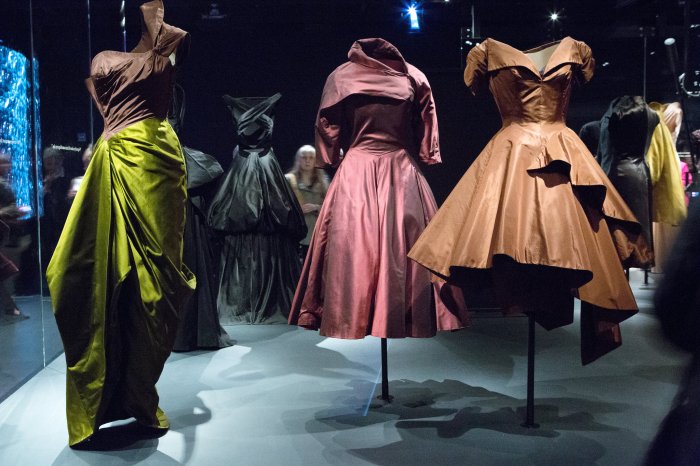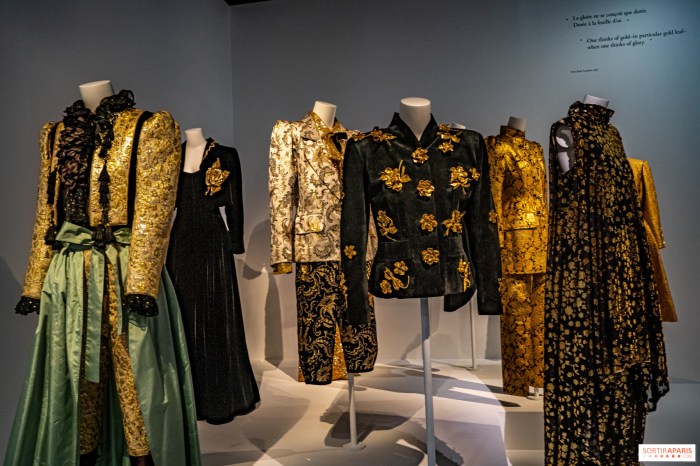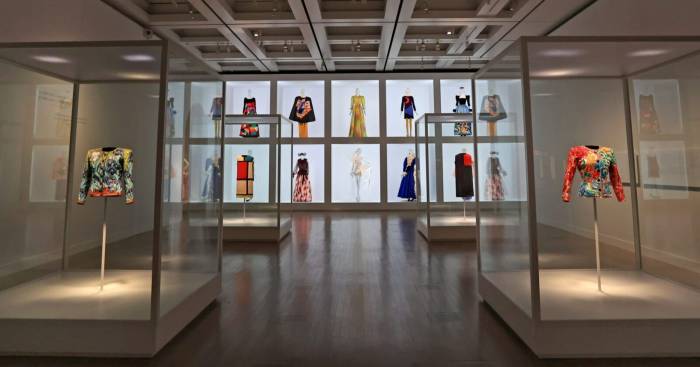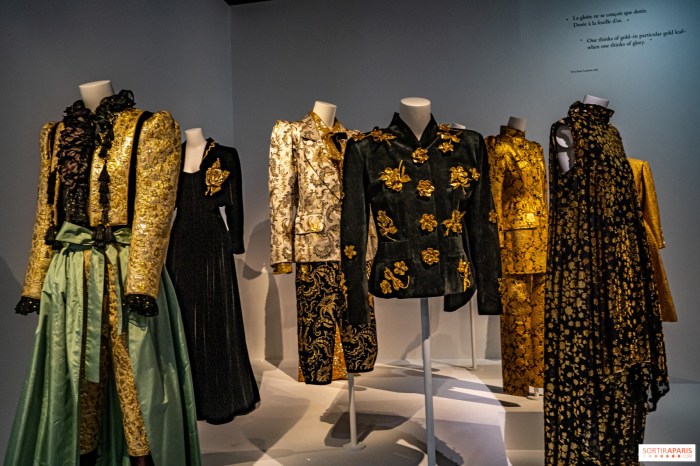Met Gala exhibitions American fashion showcase the evolution of American style through the lens of iconic events. From groundbreaking themes to influential designers, this exploration delves into the rich history of American fashion and its global impact. This blog post examines how these exhibitions reflect American identity and values, and how they have influenced popular culture.
The Met Gala, a renowned annual fundraising event, features exhibitions that delve deep into the history of fashion, often with a specific theme. These exhibitions aren’t just about showcasing clothes; they’re about understanding the cultural context and societal shifts that shaped American fashion. This post will explore how American fashion is presented through these exhibitions, and how it connects to wider cultural trends.
Overview of the Met Gala Exhibitions
The Met Gala, an annual fundraising event for the Metropolitan Museum of Art’s Costume Institute, has become synonymous with high fashion and cultural commentary. More than just a glamorous night, the Gala’s exhibitions play a crucial role in shaping our understanding of American fashion history and its global influence. The unique blend of art and fashion, combined with the star-studded attendance, makes it a significant cultural event.The Met Gala’s exhibitions are not simply showcases of designer attire; they are meticulously curated explorations of themes and concepts.
From historical periods to contemporary trends, each exhibition provides a lens through which to view American fashion’s evolution. The exhibitions delve into specific periods, movements, or designers, allowing for a deeper appreciation of the artistic and cultural context of the garments.
Evolution of Themes and Concepts
The Met Gala’s exhibitions have evolved significantly over the years. Early themes focused on specific eras, like the 1920s or the Victorian era, offering a historical perspective on fashion. Later exhibitions delved into broader themes such as “Camp,” exploring the concept of artifice and theatricality in fashion. More recent themes have examined the intersection of fashion with social and political movements, providing a contemporary commentary on society.
This evolution reflects the changing nature of fashion itself and its ability to reflect and shape cultural trends.
Iconic and Influential Met Gala Exhibitions
Several exhibitions have left a lasting impact on the fashion world and popular culture. “American Woman: Fashioning a National Identity” provided a comprehensive overview of American fashion from its colonial roots to the present day. The “Camp: Notes on Fashion” exhibition explored the unique characteristics of camp aesthetic, which influenced subsequent fashion trends. “Heavenly Bodies: Fashion and the Catholic Imagination” brought together a remarkable collection of fashion pieces that engaged with the concept of faith and beauty.
These exhibitions demonstrate the Met Gala’s capacity to present thought-provoking and visually captivating displays.
Significance in American Fashion History
The Met Gala exhibitions are invaluable for understanding the evolution of American fashion. By showcasing iconic garments, accessories, and designs, the exhibitions provide a tangible link to the past, illuminating how American fashion has developed and changed over time. These exhibitions offer insights into the cultural context in which fashion was created, showcasing the influence of social movements, artistic movements, and economic forces.
Purpose and Impact on Fashion and Culture
The purpose of the Met Gala’s exhibitions is to educate and inspire. These exhibitions act as a platform for dialogue and discussion, sparking interest in fashion history and contemporary design. By bringing together leading designers, fashion critics, and prominent figures, the exhibitions amplify the voices of those shaping American fashion. The impact extends beyond the fashion industry, influencing popular culture, art, and design across various disciplines.
Table of Met Gala Exhibitions
| Exhibition Year | Theme | Key Designers | Notable Attendees |
|---|---|---|---|
| 2015 | China: Through the Looking Glass | Alexander McQueen, Versace, Chanel | Beyoncé, Rihanna, Lady Gaga |
| 2018 | Heavenly Bodies: Fashion and the Catholic Imagination | Christian Dior, Yves Saint Laurent, Chanel | Zendaya, Katy Perry, Taylor Swift |
| 2022 | Karl Lagerfeld: A Line of Beauty | Karl Lagerfeld, Chanel, Fendi | Kim Kardashian, Kendall Jenner, Gigi Hadid |
American Fashion in the Exhibitions
The Met Gala exhibitions, a kaleidoscope of American fashion through the ages, offer a fascinating glimpse into the evolution of style, societal shifts, and cultural influences. These displays provide a unique opportunity to explore the distinct characteristics of American fashion across various eras, examining its impact on global trends and its relationship with international counterparts. By delving into the exhibitions, we can appreciate the contributions of key designers and identify iconic figures who shaped American style.The exhibitions reveal how American fashion has consistently responded to, and often anticipated, shifts in societal norms and technological advancements.
From the early 20th century’s embrace of practicality and innovation to the mid-20th century’s emphasis on glamour and rebellion, the displays underscore how American designers adapted to changing needs and desires. Furthermore, they illustrate the significant role American fashion has played in shaping global aesthetics.
Portrayal of American Fashion Styles Across Eras
The exhibitions vividly showcase the diverse American fashion styles across different eras. Early American fashion, influenced by European styles, was characterized by practical and functional garments. As America evolved, so did its fashion, reflecting the changing social and economic landscapes. The exhibitions demonstrate how American designers progressively adopted and adapted these styles to create unique national expressions.
Key Designers and Their Contributions
Several designers have significantly shaped American fashion, as highlighted in the exhibitions. Charles James, a master of couture, is prominently featured, demonstrating his pioneering approach to silhouette and embellishment. Other influential designers, such as Claire McCardell and Halston, are showcased for their contributions to American sportswear and casual wear. Their innovations in material use, construction techniques, and design aesthetics are evident in the displayed pieces.
These designers challenged conventional notions of elegance and functionality, thereby leaving a lasting mark on American fashion.
Impact of American Fashion on Global Trends
American fashion has had a substantial global impact, as evidenced in the exhibitions. The streamlined silhouettes of the 1930s and the casual sportswear of the 1940s, designed by American designers, were adopted and adapted by international fashion houses. The exhibitions highlight the influence of American fashion on global trends, particularly through Hollywood’s embrace of American styles.
Comparison and Contrast with International Styles
The exhibitions allow for a nuanced comparison of American fashion with international counterparts. While American fashion often emphasized practicality and innovation, European styles often prioritized opulence and tradition. However, the exhibitions show how these styles often influenced and borrowed from each other. For example, the influence of Parisian haute couture on American designers can be observed in certain collections, illustrating a dynamic interplay between national styles.
American Fashion Icons
- Coco Chanel: Early 20th century. While not exclusively American, Chanel’s influence on American fashion, as showcased through the exhibition’s pieces, is significant. Her minimalist designs paved the way for many American designers.
- Audrey Hepburn: Mid-20th century. Her iconic style, often characterized by chic simplicity, is a powerful example of how Hollywood stars can influence and elevate fashion trends. Exhibits would showcase her looks, demonstrating the influence of American movie stars.
- Jackie Kennedy: Mid-20th century. Known for her elegant and sophisticated style, Jackie Kennedy’s influence on American fashion is apparent in the exhibitions, showcasing the enduring appeal of her look.
- Marilyn Monroe: Mid-20th century. The exhibitions would showcase Marilyn Monroe’s iconic glamour, highlighting the impact of Hollywood on American fashion and global perceptions.
Evolution of American Fashion Silhouettes
| Era | Key Silhouette Feature | Dominant Materials | Notable Designers/Trends |
|---|---|---|---|
| 1920s | Straight, streamlined | Rayon, silk | Rise of the flapper dress, emphasizing practicality and freedom |
| 1940s | Fitted, cinched waist | Woven fabrics, wool | Impact of wartime restrictions and streamlined designs |
| 1950s | Full skirts, nipped waists | Polyester, nylon | Hollywood influence, emphasis on feminine curves |
| 1960s | Mini skirts, bold prints | Synthetics, cotton | Youth rebellion, experimentation with new styles |
Impact on Popular Culture
The Met Gala, a spectacle of fashion and art, transcends its red carpet glamour to exert a profound influence on popular culture. Its exhibitions, showcasing American fashion through diverse lenses, spark conversations, shape trends, and profoundly impact the way Americans, and the world, perceive the nation’s style and identity. Beyond the glittering gowns and celebrity appearances, the Gala’s exhibitions serve as a potent catalyst for cultural change.The Met Gala exhibitions aren’t merely static displays; they are dynamic forces that reshape the narrative around American fashion.
These exhibitions act as a powerful lens through which the public perceives not just clothing, but also the values, aspirations, and historical context that underpin American identity. This influence is multifaceted, affecting media representation, fashion trends, and the creative process itself.
Influence on Media Representation
The Met Gala’s exhibitions frequently become subjects of extensive media coverage, from print and broadcast to online platforms. This media attention significantly amplifies the visibility of the featured designers, styles, and historical periods. The Gala provides a platform for journalists and commentators to explore the connections between fashion and societal trends. This heightened awareness often translates into increased public interest and appreciation for American fashion heritage.
For example, the 2022 “In America: A Lexicon of Fashion” exhibition generated significant media buzz, featuring articles and discussions in leading fashion publications, showcasing the evolution of American fashion in popular culture.
Met Gala exhibitions showcasing American fashion are always fascinating, aren’t they? Thinking about the incredible designs and historical context, I’m reminded of how much I’d love to visit Boise, Idaho. There are plenty of exciting things to see there, like the great outdoors and historical landmarks. For a full list of Boise’s top attractions, check out this great resource: top things to do in boise.
Ultimately, these exhibitions are a window into American creativity and style, inspiring exploration of both the past and present.
Connection to American Fashion Identity
The exhibitions profoundly contribute to the development and evolution of a distinct American fashion identity. By highlighting the diversity of American designers and their approaches to fashion, the exhibitions foster a more nuanced and comprehensive understanding of the nation’s stylistic landscape. The exhibition themes, ranging from the country’s early sartorial traditions to contemporary innovations, provide a historical context for appreciating the unique evolution of American fashion.
For instance, the “Camp: Notes on Fashion” exhibition in 2019 fostered a discussion about unconventional aesthetics and their role in shaping cultural identity.
Shaping Public Perception of American Fashion and Designers
The Met Gala’s impact on public perception is undeniable. By showcasing the work of both established and emerging designers, the exhibitions often elevate their profile and garner recognition beyond their initial circles. The Gala provides a high-profile platform to showcase the creativity and skill of American designers, encouraging broader appreciation and potentially fostering future collaborations and entrepreneurial ventures.
Furthermore, the Gala showcases the rich history and ongoing innovation of American fashion, often leading to renewed interest in the works of lesser-known designers and periods.
The Met Gala’s American fashion exhibitions are always a spectacle, showcasing the evolution of style. Thinking about the glitz and glamour, I can’t help but imagine unwinding at one of the best all inclusive adults only resorts in Mexico best all inclusive adults only resorts in mexico after a night of fabulous fashion. The vibrant culture and stunning scenery would be the perfect post-gala escape, though I’m already excited to see what next year’s exhibition brings!
Impact on the Creative Process and Innovation, Met gala exhibitions american fashion
The exhibitions often inspire new creative directions and innovative approaches in American fashion design. Exposure to historical styles and artistic movements can spark creativity, encouraging designers to experiment with new materials, silhouettes, and aesthetics. The Gala’s emphasis on originality and exploration serves as a catalyst for innovation. For instance, the 2023 exhibition on American sportswear influenced designers to rethink traditional athletic wear, leading to fresh interpretations of the genre.
The Met Gala’s exhibitions on American fashion are always fascinating, showcasing the evolution of style over the years. But with Venice Beach, California, recently crowned the best in the United States, it’s clear that American fashion isn’t just about haute couture. It’s about the everyday, the street style, and the vibrant energy of places like Venice, influencing trends seen on the Met Gala runway in unexpected ways.
So, while the exhibitions explore high fashion, the influence of places like Venice Beach offers a unique and inspiring perspective on American style.
Discussions About American Identity and Values
The exhibitions, by their very nature, invite discussions about American identity and values. The themes explored often touch upon cultural shifts, social movements, and evolving societal norms. The presentations offer opportunities for the public to contemplate how fashion reflects and shapes American identity over time. This reflective engagement encourages deeper understanding and appreciation of American culture, encouraging dialogue about values and cultural narratives.
Exhibition Themes Reflected in Popular Culture
| Exhibition Theme | Examples in Popular Culture – Fashion Trends | Examples in Popular Culture – Media Representation | Examples in Popular Culture – Social Discourse |
|---|---|---|---|
| American sportswear | Athleisure fashion becomes mainstream | Sportswear designers gain media attention | Discussions on comfort vs. style in fashion |
| Punk | Punk aesthetics incorporated into modern fashion | Increased coverage of punk fashion history | Renewed interest in alternative subcultures |
| Camp | Outlandish and exaggerated fashion styles | Increased visibility of queer and unconventional fashion | Discussions about unconventional beauty standards |
| Early American fashion | Historical silhouettes reinterpreted in modern designs | Increased interest in historical fashion | Discussions about the evolution of American style |
Visual Representation of American Fashion
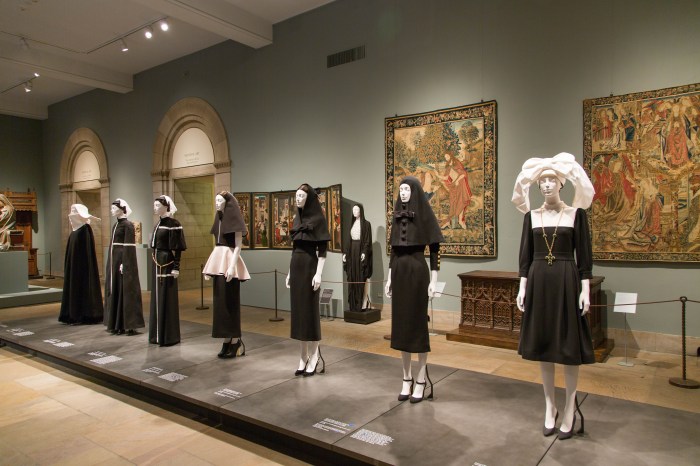
The Met Gala exhibitions on American fashion provide a captivating visual narrative, transporting viewers through the evolution of style and craftsmanship. These exhibitions don’t simply display garments; they weave a rich tapestry of history, culture, and innovation. The visual approach employed tells a compelling story about American identity and its relationship with fashion.The exhibitions leverage a range of visual elements, from meticulously curated displays to evocative imagery and carefully chosen design choices, to effectively communicate the multifaceted nature of American fashion.
The presentations aim to capture the spirit of the era, the cultural context, and the unique perspectives of various designers and communities.
Imagery and Design Choices
The exhibitions employ a diverse range of imagery to showcase American fashion’s evolution. Photographs, illustrations, and even video installations transport viewers back in time. The design of the exhibits themselves plays a crucial role in setting the tone. The arrangement of garments, lighting, and background elements all contribute to the overall experience. Color palettes and stylistic choices are carefully considered to reflect the aesthetic of each era and design movement.
Diverse Perspectives of American Fashion
The exhibitions successfully portray the diversity of American fashion perspectives. They showcase designs from various communities and cultural backgrounds, highlighting the contributions of designers from different ethnicities, genders, and social classes. This diverse representation underscores the rich tapestry of American identity and style. Exhibits might feature clothing from African American designers, or dresses from the American West, providing a multifaceted view of the nation’s fashion history.
Craftsmanship and Artistry
The exhibitions often include detailed displays of the craftsmanship behind American fashion. Close-up shots of intricate stitching, embroidery, or embellishments are frequently featured. Models and mannequins are often meticulously styled to demonstrate the garments’ original intent. This focus on craftsmanship and artistry provides a deeper understanding of the skill and dedication required to create these pieces. The quality of materials used and the level of detail in the construction are often highlighted.
Historical Context and References
Historical context is vital to understanding American fashion’s evolution. The exhibitions use period-appropriate settings, props, and background elements to immerse viewers in the specific era being presented. Designers’ biographies, archival materials, and contextual information are often included to enrich the understanding of the fashion’s historical significance. The exhibitions might include timelines and explanations of social and cultural influences on fashion trends.
Powerful Imagery and Symbolism
Powerful imagery and symbolism are often used to communicate deeper meanings. Certain garments might be displayed with specific accessories or in particular settings to evoke strong emotions or highlight their symbolic value. For example, a photograph of a protest dress could be accompanied by texts or images detailing the social movement it represents. Color symbolism, imagery related to cultural movements, and other visual elements are used to strengthen the message of the exhibition.
Visual Elements in American Fashion Exhibitions
| Visual Element | Historical Context | Impact | Example |
|---|---|---|---|
| Period-appropriate settings | Convey the historical context of a specific era. | Immersive experience, allowing viewers to step back in time. | A 1920s flapper dress displayed in a room decorated with Art Deco elements. |
| Detailed displays of craftsmanship | Highlight the skill and dedication of designers and artisans. | Appreciation for the artistry and meticulous work involved. | Close-up view of a hand-painted silk gown, showcasing the intricate details. |
| Diverse representation of designers | Showcasing the contributions of various communities and cultural backgrounds. | Broader understanding of the rich tapestry of American identity and style. | Exhibiting clothing from African American designers or garments designed by Native American artisans. |
| Use of powerful imagery and symbolism | Communicate deeper meanings and evoke specific emotions. | Engaging viewers on a more profound level and creating lasting impressions. | Displaying a dress from the Civil Rights movement alongside related protest posters. |
Exhibitions and Fashion Sustainability
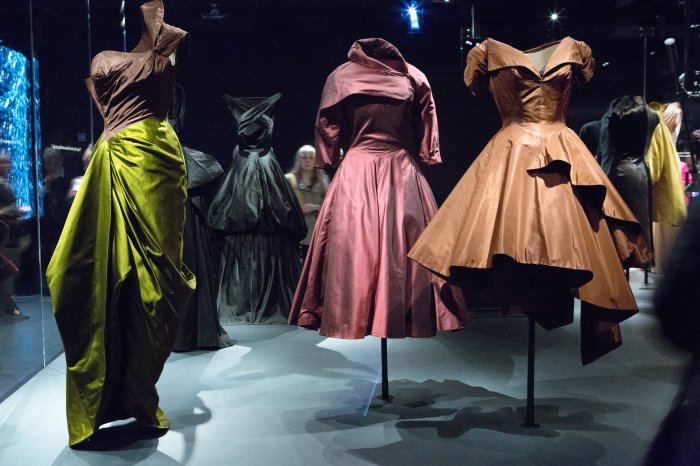
The Met Gala exhibitions, particularly those focused on American fashion, offer a unique platform to explore the intersection of design, cultural impact, and sustainability. These exhibitions, by showcasing historical trends and contemporary practices, can illuminate the evolving relationship between fashion and environmental consciousness. Examining the exhibitions’ treatment of sustainability reveals valuable insights into the industry’s progress and potential for future change.The exhibitions’ approach to sustainability, while often implicit within the historical narratives, can also be explicitly highlighted.
By examining the materials, design choices, and production processes of featured garments, the impact of these practices on the environment and society can be analyzed. Comparative analyses with international sustainable fashion practices can provide a broader context for evaluating American fashion’s efforts.
Sustainable Practices in American Fashion
The exhibitions provide a glimpse into the use of sustainable materials and practices within American fashion. From the use of organic cotton and recycled fabrics to the integration of innovative techniques for reducing waste, the exhibitions showcase various approaches. This allows for a comparative analysis with international efforts.
Examples of Sustainable Designers
Numerous American designers have embraced sustainable practices in their work. These designers are often featured in the exhibitions and their choices provide valuable case studies.
- Stella McCartney: Known for her commitment to cruelty-free materials and eco-friendly production processes, her designs are frequently highlighted in discussions of sustainable fashion. Her use of vegan leather and innovative fabric technologies are often cited as examples.
- Gabriela Hearst: Known for incorporating recycled materials and ethical production methods into her designs, Hearst’s work often prioritizes sustainability.
- Eileen Fisher: This brand has long been committed to environmentally conscious design. Their use of organic cotton and their focus on durability and longevity are examples of this commitment.
These examples demonstrate the commitment some American designers have to ethical and sustainable practices, often incorporating recycled or natural materials and eco-friendly production methods.
Exhibition’s Approach to Eco-Conscious Fashion
The exhibition’s approach to showcasing eco-conscious American fashion can vary. Some exhibitions may explicitly focus on designers and brands with a strong sustainability ethos, while others may integrate these elements more subtly within broader historical narratives. The curation often reflects the changing attitudes towards sustainability within American fashion over time.
Comparative Analysis of American and International Practices
A comparative analysis of sustainable practices in American fashion with those in other countries reveals a mixed picture. While American designers have embraced innovative sustainable techniques, international trends often exhibit a more comprehensive approach to circularity and waste reduction across the entire supply chain. Examples of international sustainable practices include the use of innovative textile recycling technologies and the adoption of closed-loop systems in manufacturing.
Table: Sustainable Designers and Practices
This table highlights examples of designers, materials, and sustainability efforts presented in the exhibitions:
| Designer | Materials Used | Sustainability Efforts | Specific Examples (from Exhibitions) |
|---|---|---|---|
| Eileen Fisher | Organic cotton, recycled fabrics | Reduced water usage in production, durable designs | Specific garments showcasing these materials and production methods |
| Stella McCartney | Vegan leather, innovative fabrics | Cruelty-free materials, eco-friendly production processes | Showcases of vegan leather and innovative fabric technologies |
| Gabriela Hearst | Recycled materials, natural fibers | Ethical production methods, circularity | Garments incorporating recycled materials and natural fibers |
| Other American Designers (from the exhibitions) | (List of materials from various designers) | (List of sustainability efforts from various designers) | (Specific examples of garments and design choices from the exhibitions) |
Wrap-Up: Met Gala Exhibitions American Fashion
In conclusion, Met Gala exhibitions offer a compelling narrative of American fashion, highlighting its evolution, global influence, and impact on popular culture. The exhibitions aren’t simply about showcasing clothes; they are a powerful reflection of American identity and values, presented through visual storytelling and historical context. From iconic designers to sustainable practices, these exhibitions offer a multifaceted view of American fashion’s rich tapestry.
